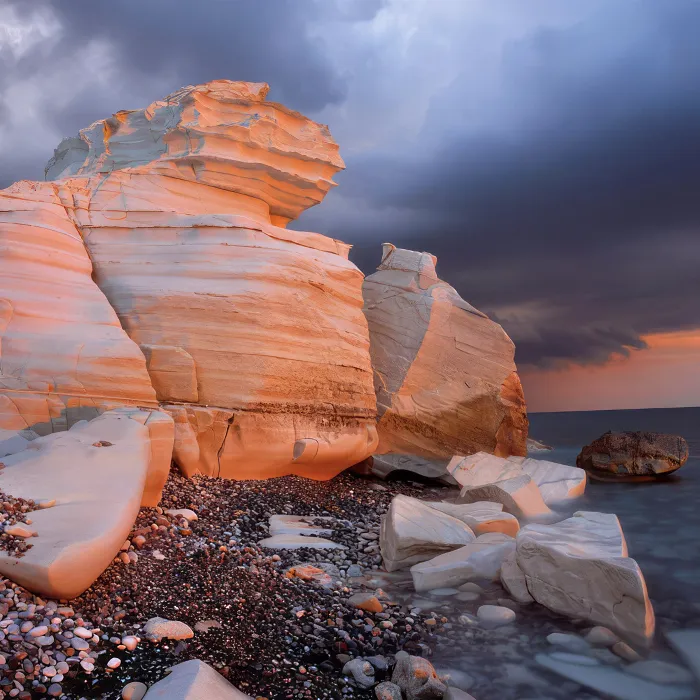"Mountains in the light" - the Pucajirca Central, illuminated by the rising sun. It's "only" a classic and has been photographed thousands of times, but (at least for me) it's always beautiful.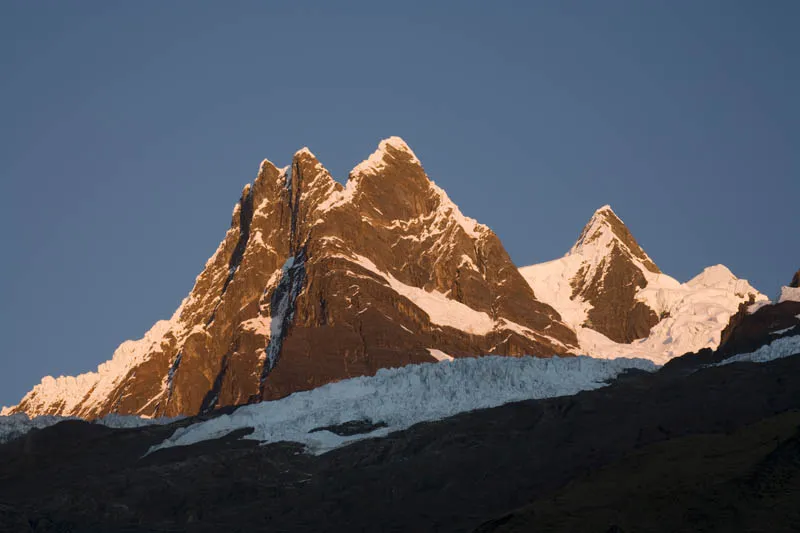
Canon EOS 5D, Zeiss Vario Sonnar f 4.5-5.6 100-300 mm at 200 mm and Blender 8, ISO 100, shutter speed 0.3 seconds, tripod, Pucajirca Central, Cordillera Blanca, Peru.
You never stop learning. This sentence has accompanied me as a photographer for 20 years. My professional life is a constant challenge, coupled with the need to keep learning. A few days ago, I returned from a big (for me) tour. The goal: to cross the Alps at their widest point on touring skis in 15 days, a winter ski transalp. Beforehand, I dreamed of spending the night at high altitude, of unique light and many impressive landscapes. Although we successfully completed the project, a lot of things turned out differently than I thought in terms of photography.
The heavy rucksack (approx. 22 kg) and the alpine terrain required all my discipline for many photos on the Skitransalp. Backpack down, camera out, lens change, lay down in the snow and take a few pictures. Then everything in reverse order ... that's reportage photography in the high mountains.
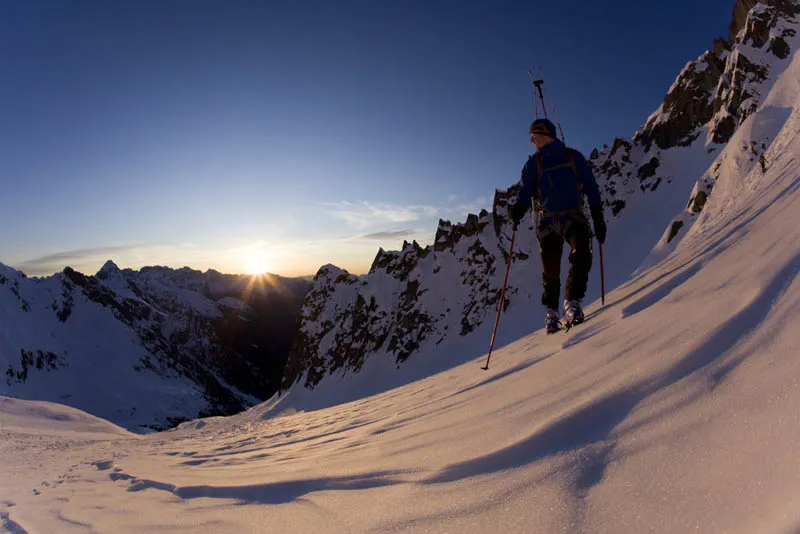
Canon EOS 5D Mark II, EF f2.8 15 mm at Blender 9 and ISO 400, shutter speed 1/640 second. Ascent to Care Alto, Adamello Group, Italy.
The weather, the conditions and the route itself were much more challenging than expected. We were usually on the move for between 10 and 13 hours and only arrived at the next hut late in the afternoon. There we were usually physically and mentally "at the end". We just wanted to rest and eat and drink as much as possible. It was simply impossible for me to go up somewhere again afterwards to photograph beautiful landscapes. On the other hand, I was able to take much more exciting and authentic reportage photos than expected. At first I was surprised, perhaps even a little disappointed. But after a short time it became clear that reality was stronger than my desire. Nature had told me with all its power and clarity what the situation was. And nature ultimately has the upper hand.
Temperature minus 18 degrees, 3400 meters altitude, wind speed over 100 km/h. All of this was reason enough for me not to unpack the large SLR camera, but to take this snapshot on the ski transalp with the compact camera that is always to hand: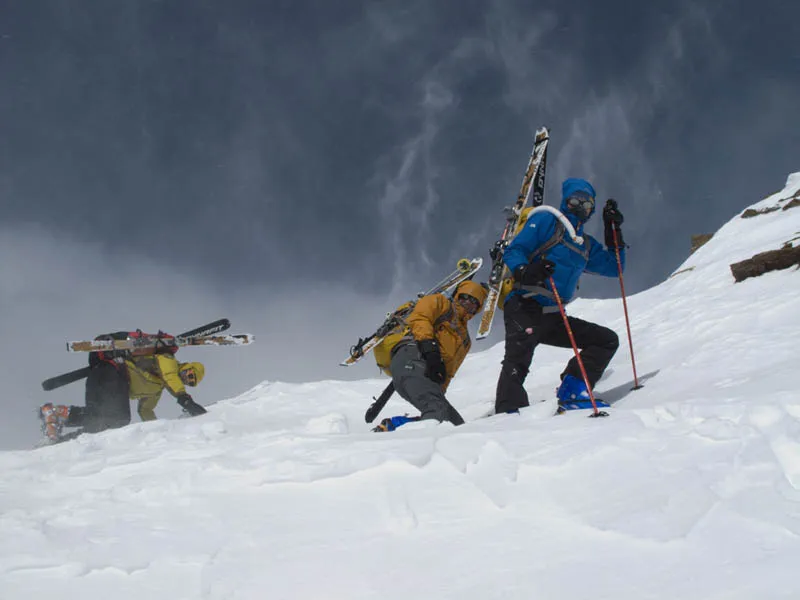
Canon G10, Blender 5, 1/2500 second, ISO 200, Innere Quellspitze, Ötztal Alps, Tyrol, Austria.
What do I want to and can I pass on to you with this last tutorial? This time it's neither technical tips nor equipment recommendations. It's more about the basic approach to photographic projects and dreams and how to plan and implement them.
You can photograph "mountains in the light" even in the often hot and hazy height of summer. This shot was taken after a thunderstorm had passed and lives from the contrasts between the sunlit areas and the dark shadows of the last gray clouds.
Canon EOS 1Ds Mark III, EF f4 300 mm L IS at Blender 9 and ISO 125, shutter speed 1/100 second. Watzespitze, Ötztal Alps, Tyrol, Austria.
1. letting yourself drift
An incredible amount in our lives is predetermined. The clock is our constant companion. Can we even let go? Imagine the following situation: You have a few days to spare. Your photo backpack is packed with a mixture of equipment for landscape photography and a few accessories for macro photography. Also in your luggage: various maps and the necessary mountain equipment. Not included: ambitious goals and the cell phone. For once, the weather reports don't matter. Good music plays during the journey (where are we actually going?). Then suddenly there's a spring meadow, behind it a mountain, behind it a lake and, and, and. Can you imagine what freedom it can mean to be able to just stay here? You lie down in the meadow and look through the viewfinder. A photographic microcosm opens up that makes you forget everything else. Creativity can begin right here and now. My tip: don't plan every photo tour with a start and finish, but follow your own feelings, moods and whims.
A day on which I let myself drift. I headed west into the Lechtal Alps and had the right light in exactly the right place.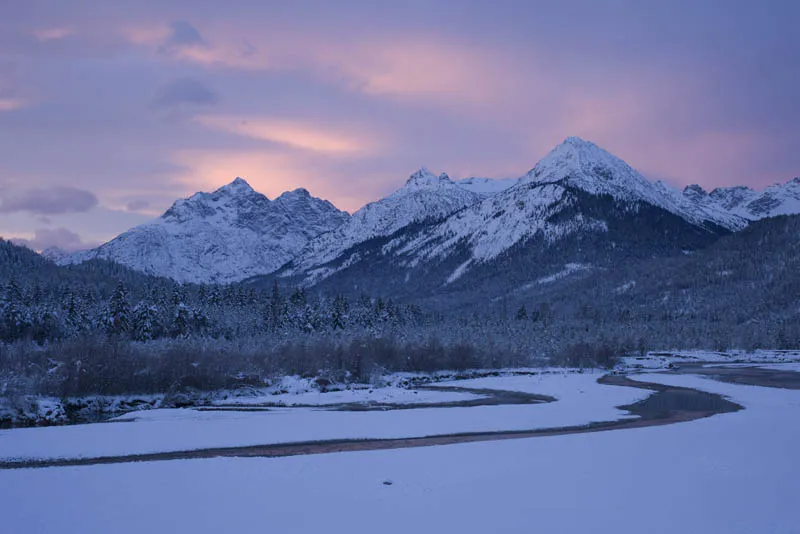
Canon EOS 1Ds Mark III, Zeiss Vario Sonnar 3.5-4.5 28-70 mm at 35 mm, Blender 8 and ISO 800, shutter speed 1/8 second. Lechtal, Lechtal Alps, Tyrol, Austria.
2 The planned tour
Often, however, we know what we want. We have a motif in mind, a specific mountain as a destination or a concrete photographic project. We pack our mountain and photographic equipment according to the requirements. We study maps and guides. Sometimes we even have to train for a specific destination in the mountains. But what are the main photographic factors to consider when planning?
This picture was preceded by maximum planning. The day before I took the picture, I climbed the entire 1000 meters of altitude above Seefeld to look for different viewpoints for a project. The following night, not only did I know where I was going to photograph what, but I was also lucky enough to get some fantastic light.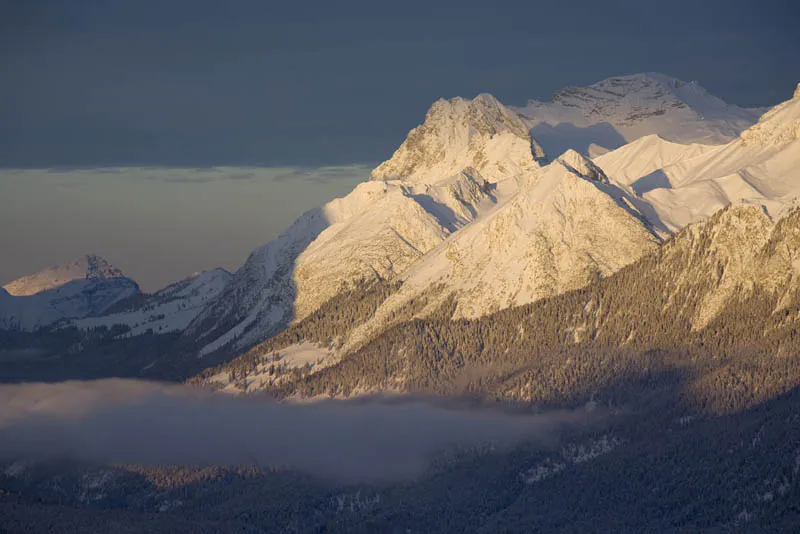
Canon EOS 5D Mark II, Zeiss Vario Sonnar f 4.5-5.6 100-300 mm at 300 mm and Blender 8, ISO 100, shutter speed 1/30 second, tripod, Wetterwandeck from the east, Wetterstein mountains, Austria.
2.1 Studying the literature
If you want to avoid surprises or get inspiration in advance, you can browse through existing pictures, postcards or illustrated books on the planned region to find good initial viewpoints and motifs. But be careful: inspire yes - copy no. If you only copy, you are not creative and will not become creative. Neither the joy nor the satisfaction of a good picture will really come from a "copy".
Cyprus was new photographic territory for me, so I prepared myself meticulously by studying the literature and found a boring photo of these rocks in a travel guide, taken around midday. However, it was clear to me that there was more to it photographically. I spent three evenings there until I finally got this incredible light.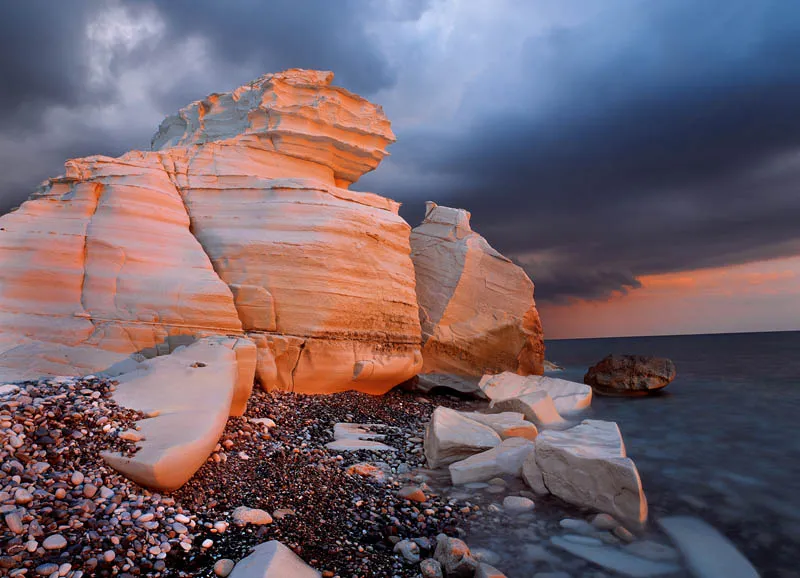
Contax 645, Planar T f3.5 35 mm, Blender 16, 1/2 second, Fuji Velvia 50, tripod, Petratu Romiu, Cyprus.
2.2 Map study
I use good maps to work out my photographic goal. Among other things, the following questions need to be answered: Where might be good viewpoints, for example mountain lakes with beautiful scenery behind them or elevated points such as hilltops, ridges or other peaks with good distant views? Where does the sun rise and which part of the motif, whether mountain, lake or hut, does it illuminate? Another important point to consider: is there another mountain in the direction of sunrise that could block the light? Incidentally, a GPS device can never replace a good map for planning. We also need the complete overview of a map (scale 1:25,000 or 1:50,000) to plan a photo tour in landscape photography.
The last rays of sunshine before a large area of low pressure conjure up this inhospitable atmosphere over the Friesenbergsee. This viewpoint can be clearly identified as suitable on a good map, for example: After the lake, the slope drops steeply into the valley and opposite is the striking Zillertal main ridge.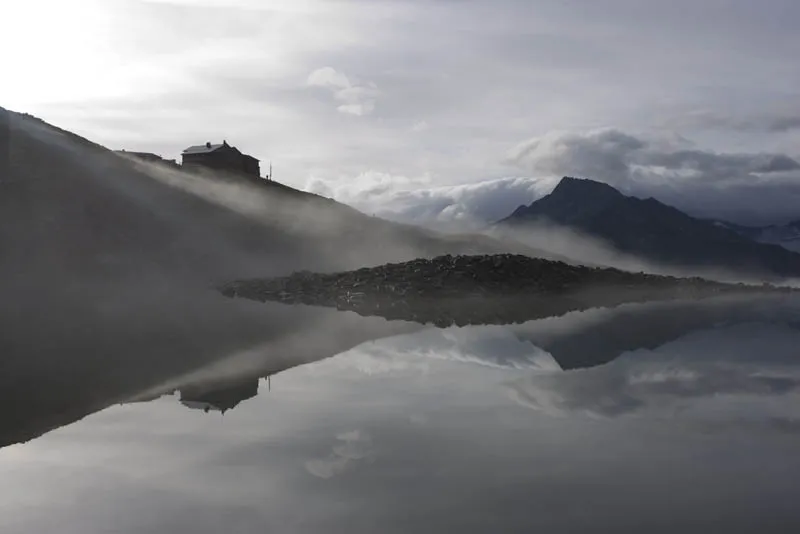
Canon EOS 1Ds Mark III, EF f4 17-40 mm L at 40 mm and Blender 10, ISO 50, shutter speed 1/100 second, tripod. Friesenbergsee, Zillertal Alps, Tyrol, Austria.
2.3 The weather factor
I meticulously follow the weather reports before every tour. Of course, it makes no sense to plan the west side of a mountain in the evening light if warm, humid air masses from the southwest ensure a high probability of thunderstorms in the afternoon every day. In such a situation, I look for an east-facing exposed destination for the sunrise, as the air is usually clear for a short time after an evening thunderstorm and beautiful sunrises are at least likely. Before every tour, I also research the exact sunrise and sunset times via local newspapers or the internet.
I have rarely run so fast up a hilltop in deep snow - just to get this picture. The light lasted less than a minute. "Mountains in the light" also has to do with luck ...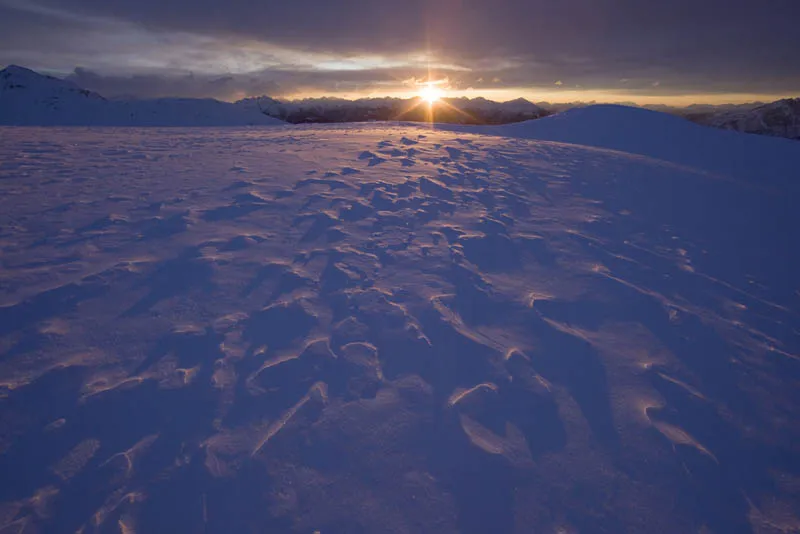
Canon EOS 5D Mark II, EF f2.8 14 mm L II at Blender 10 and ISO 800, shutter speed 1/500 second. Morning mood on the Goisele, Schober group, East Tyrol, Austria.
2.4 The location search
Sometimes I feel like a location scout. A lot of my time in the mountains is spent "seeing and searching". Take the Zugspitz west face, for example. The Bleispitze in the Lechtal Alps is a wonderful location for this. But where there, at the summit, on the ridge? My schedule always allows for one to two hours to look for a location. This means that if the sun sets at 6 p.m., I'm on site by 4 p.m. at the latest to look for a nice viewpoint or a suitable foreground.
2.5 The schedule
Stress and time pressure are creativity killers in the mountains! That's why it's important to work out a schedule and stick to it, at least for planned tours. However, the time planning for a photo hike in the mountains is relatively simple: average hikers should calculate with 300 meters of ascent per hour in view of the heavy photographic equipment. If the route includes long flat stretches, add another hour for every 4 kilometers covered.
An example: For a sunset tour on the Jochberg in the Bavarian foothills, you should plan 2 to 2.5 hours walking time to the summit. The ascent from the Kesselberg has a good 700 meters in altitude and does not include any major flat sections. You will also need around 1-2 hours to find a location. If the sun sets at 6 pm, we recommend starting at 2 pm.
A small person on a big mountain, plus the warm light of the low autumn sun. The extreme wide-angle lens shows the vastness of the high mountains.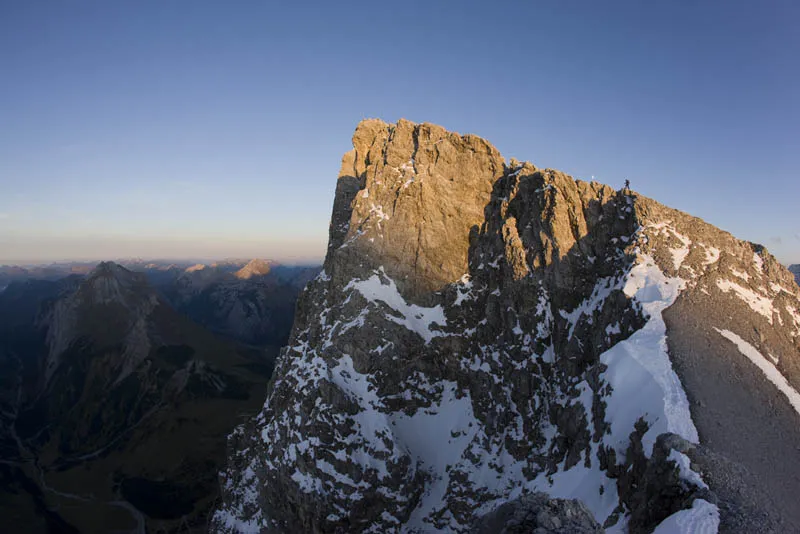
Canon EOS 1Ds Mark III, EF f2.8 15 mm at Blender 8 and ISO 200, shutter speed 1/100 second. Ascent to the Lalidererwand, Karwendel mountains, Tyrol, Austria.
3. alone or in a group?
When am I more creative? When I'm surrounded by other photo enthusiasts or when I'm all alone and therefore undisturbed and flexible on tour? Both have their appeal. On the one hand, you can learn a lot from like-minded people, but on the other hand, for many people it is not possible to completely let go of everyday life and thus be open and creative for motifs. So my tip is to dare to go it alone and enjoy being out and about on your own. One sentence here is representative of many, often unspoken feelings: "there is nothing better than being allowed to travel alone and nothing worse than having to travel alone".
We have been photographing a small private concert of Peruvian musicians in our tent camp for two hours. Everyone is focused on portraits and dance scenes. The whole photo trekking group (15 people) is taking photos, dancing and celebrating. Just for a brief moment, the Pucajirca Norte peeked through the clouds. I just had to turn around. Group dynamics my ass.
Canon EOS 5D, Zeiss Vario Sonnar f 4.5-5.6 100-300 mm at 250 mm and Blender 8, ISO 250, shutter speed 1/320 second, Pucajirca Norte, Cordillera Blanca, Peru.
4. variety
In ecological terms, material modesty is more important to me than ever. Nevertheless, I need extensive camera equipment including accessories such as flash units, fill lights and tripods in order to meet the very different requirements of my very demanding clients.
What am I getting at? I am in the fortunate position (and grateful for it) that I can choose between many different lenses depending on the photo tour. This brings variety into my everyday photography life, which has been going on for 20 years. Sometimes I only go out with two lenses: the 100 mm macro lens and the 21 mm wide-angle lens. On the one hand, "less is sometimes more", and on the other, I make much more intensive use of the reduced technical possibilities. My eye is not irritated by countless possible angles of view, but concentrates on a few clearly defined perspectives.
I often spend weeks on large advertising productions where I have ten or more lenses with me. But it is precisely this extreme alternation between maximum technology and minimalism that gives me the necessary variety and keeps my photography fun. My tip: if possible, vary the equipment and the content, e.g. one tour with a focus on macro photography, another with the aim of photographing wide panoramas. This brings variety and is a challenge at the same time.
On this evening at the Spitzkoppe in Namibia, I was completely fixated on the 14 mm super wide-angle lens. But it was this narrow crevice in the rock that satisfied my search for an unusual subject. I placed the camera directly on the rock, supported the lens with small stones until I got the right framing and released the shutter with a cable release.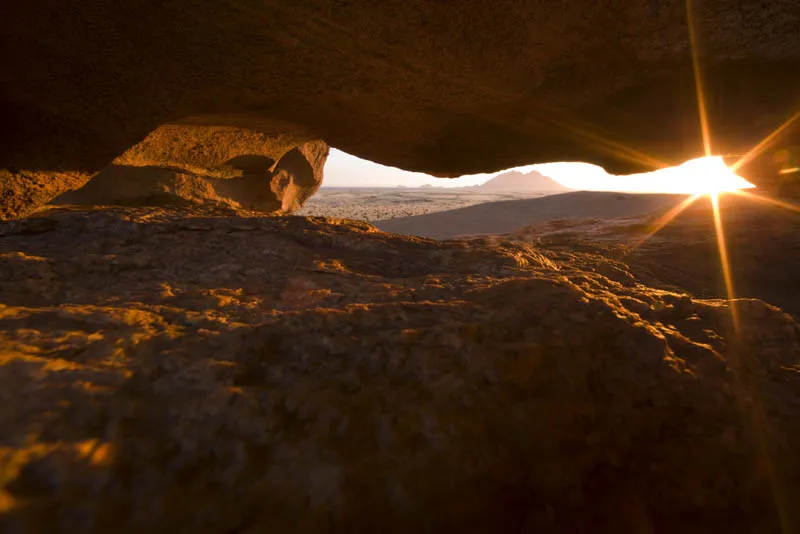
Canon EOS 1Ds Mark III, EF f2.8 14 mm L II at Blender 22 and ISO 50, shutter speed 1.6 seconds. Spitzkoppe, Namibia.
5 The enjoyment factor
Is it really only the photography in the mountains that brings the fun, the confirmation, the bliss? I don't think so. As I myself come from a mountaineering background, I have always believed that "the journey is the reward". However, when the right light sets the scene for the landscape in the right place, I'm naturally on "180" and fully focused on my photography. Nevertheless, I try to put the camera aside from time to time and simply enjoy the landscape, the light and the moment. No photo in the world is worth as much to me as the experience or the unforgettable impressions of a sunset on the Olperer.
This evening on the Olperer has burned itself deep into my memory. There's only one tip for moments like this: don't just take photos - look, feel and enjoy.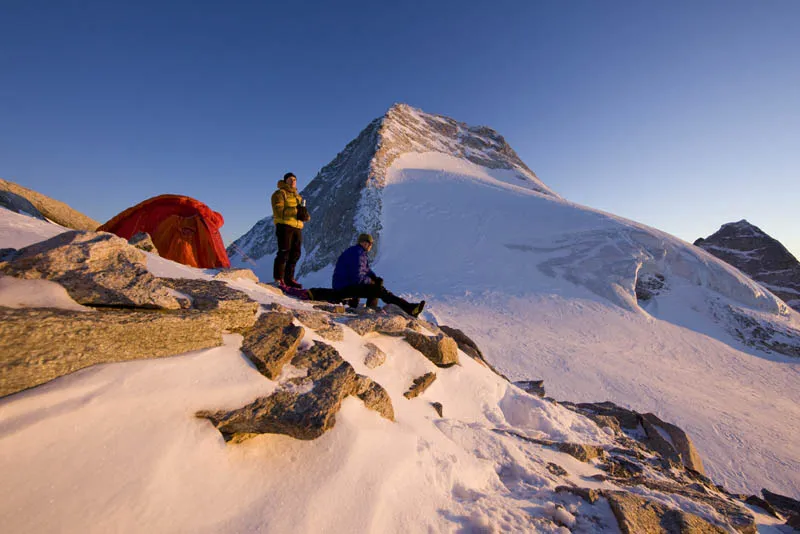
Canon EOS 5D Mark II, EF f2.8 14 mm L II at Blender 10 and ISO 400, shutter speed 1/125 second. Olperer, Zillertal Alps, Tyrol, Austria.
I am writing these last lines shortly after Easter 2009. One of my current dreams, the ski transalp, has come true. All other projects and commissions have also been completed, the pictures have been handed in and the invoices have been issued. Some assignments and projects were nice and appealing, others less so. But even the latter are simply part of securing our existence. What comes next is the freestyle. I'm free again. With new ideas, new images in my head and lots of mountaineering goals in my heart. Let's see what can be realized. I would like to take this opportunity to thank you for the time and attention you have given to my tutorials and, above all, thank you for all the emails. Have fun in the mountains and enjoy your photography.
Bernd Ritschel
The Zillertal Alps in the last twilight. I set the light accent in the foreground with the cold LED light of my headlamp.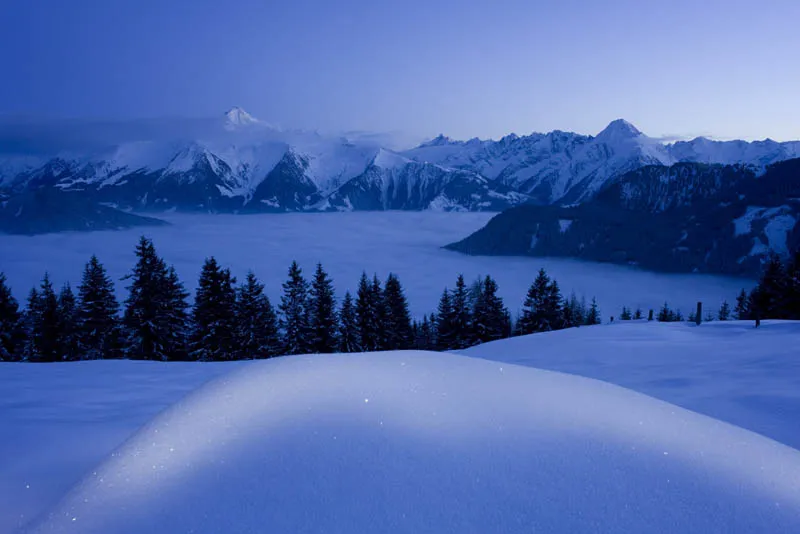
Canon EOS 1Ds Mark III, Zeiss Vario Sonnar 3.5-4.5 28-70 mm at 35 mm, Blender 16 and ISO 250, shutter speed 5 seconds. Ahornspitze, Zillertal Alps, Tyrol, Austria.
